|
by Gerald Warner,
Softball Pitching Instructor

There
are three primary phases of the pitching sequence
that
contribute to the speed and control of the pitch.
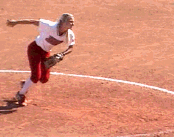 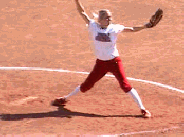
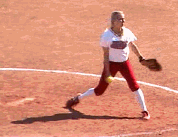
Explosive drive off the rubber Weight back on the
downswing Pushback on the stride
leg
These are the
common elements of virtually every high-velocity pitcher. These photos were
selected at random from analyses of hundreds of pitchers from 12 to
21-years old.
THE DRIVE OFF THE PITCHING
RUBBER…“EXPLODE” - 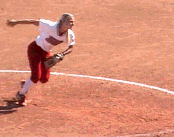 
Similar
to a sprinter coming off the starting blocks, it is the speed of a
pitcher’s drive off he rubber that lays the groundwork for a fast
pitch. Although many
pitchers are told to focus on the length of their stride,
explosive speed is essential. A pitcher needs to
feel that she has a “spring” in her pushoff leg, so when she
transfers her weight and leans into the pitch, she can drive
fast off the rubber.
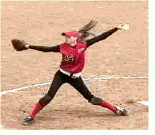
“REACH BACK” THROUGH THE
DOWNSWING –
Many
pitchers make a larger arm circle by reaching back (toward
2nd base) as they reach the “open trunk” halfway point in their arm
rotation. As seen here,
it is common for a pitcher to actually tilt her upper body backwards
and reach back toward 2nd base to get a larger, better
“whip” of her arm down through the release of the
pitch.
FINISH TALL WITH GOOD
PUSHBACK RESISTANCE – 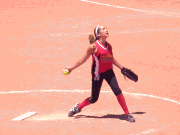 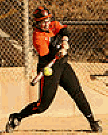
The same
resistance that a hitter gets from her front leg at the point of
contact, a pitcher needs to “set up a wall” and use her stride leg
as the resistance for the final downswing into the release of a
pitch. At the release
point the pitcher’s:
(1) landing leg is straight at a 15 to 25
degree angle, (2) upper body is erect, and (3) well back from the
front foot, (4) shoulders are three-fourths (or less) closed, and
(5) hips are halfway (or less)
closed.
The most common
mechanics elements in virtually all experienced, high-speed
pitchers are:
(1) Good
body lean and low explosive pushoff to get a fast drive off the
rubber
(2) An extra
“reach back – weight back” effort she puts into her
downswing
(3) Getting
“strong front wall” resistance from her landing leg, and finishing
tall
____________________________________________________________
NOTE: The printable version of this article
(below) contains additional photos.
This article above can be downloaded and
printed from Microsoft Word

Do you want to reprint this article or use it
on your website or in your newsletter?
As long
as it is not for profit, our only requirement is that you first
notify us, then include the following sentence:
Article by Gerald Warner of
PitchSoftball.com
and include a reference to this
website: www.pitchsoftball.com
If you have questions or
need more information
E-mail us, or
call Pitching Instructor Gerald Warner in Colorado at
(720) 200-4575
| 











